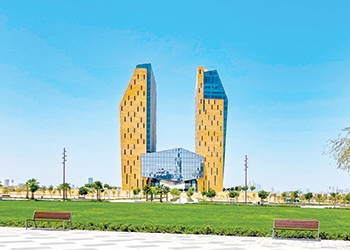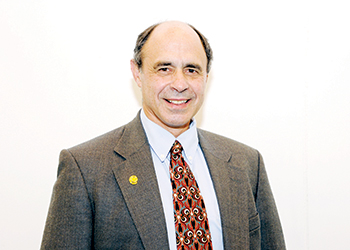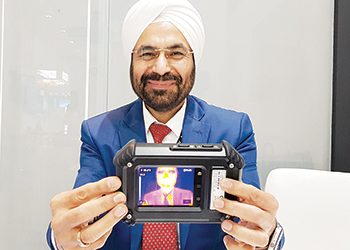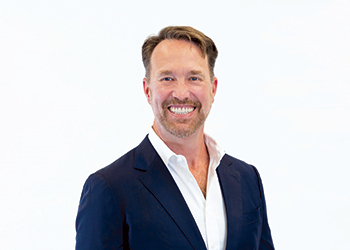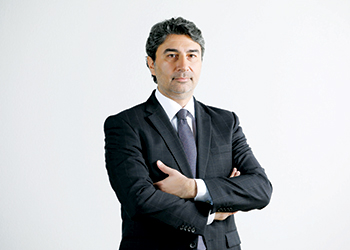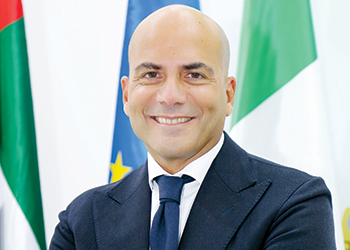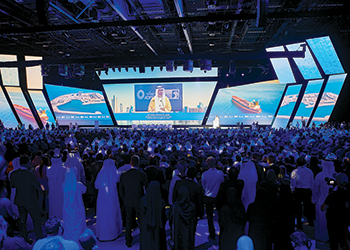
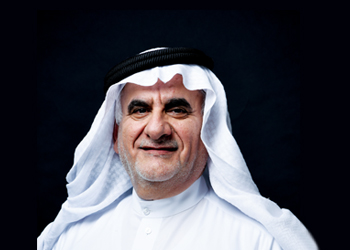 Al-Mazro ... shifting industry trends in decarbonisation
Al-Mazro ... shifting industry trends in decarbonisation
Gulf Cryo, a key player in the manufacturing and distribution of industrial, medical and specialty gases across the GCC, MEA, Egypt and Turkey, can rightly be called a frontrunner in carbon capture of industrial emissions and the production of clean carbon dioxide (CO2) in the region.
The company, which was established in 1953, has practically led the sector from a time when little was known about CO2 capturing methods and today has the confidence of major oil and gas industry companies and petrochemicals facilities.
In an exclusive interview with Abdulaziz Khattak of OGN energy magazine, Eng Abdulsalam Al-Mazro, Vice-Chairman of Gulf Cryo spoke at length about CO2 production and the reduction of emissions in the region, as well as the issues faced by the sector and what the future holds for the carbon industry.
Al-Mazro has been with Gulf Cryo for the last five years. Before that he was vice-president at Sabic looking after polymers, chemicals and industrial gases.
 |
|
A recovered Co2 treatment plant |
What was the intent behind Gulf Cryo’s sponsorship of the Decarbonization Zone at ADIPEC 2022?
Gulf Cryo is one of a few companies in the carbon capture business since 2014, that's before the Paris Agreement of 2015. We were frontrunners I believe, investing in and adopting a cleaner alternative to supply CO2 before it was clear to the world that it is a must.
Before we started capturing CO2, diesel was burned to make it. But we could show how CO2 could be recovered from industries instead, and tried to convince the markets to stop burning diesel.
From there, we have expanded our decarbonisation solutions and I can proudly say we are sector leaders in the region.
We believed in our ambition, and we are still very committed to that route. So, sponsoring the Decarbonisation Zone was the right extension to our business and to that commitment.
Moreover, the oil industry (gathered at Adipec) has seen a major shift. The industry itself is no longer limited to oil and gas. It’s taken a holistic approach with a sustainability agenda covering the whole ecosystem of energy production and consumption, including alternative energy, decarbonisation solutions, etc.
So the core responsibility of energy ministries has shifted from oil production to environment preservation and sustainability. And we rightfully fall into this ecosystem with our solutions in decarbonising industries.
How did Gulf Cryo start producing clean CO2 that early?
CO2 is one of the several gases we have been producing for a long time beside oxygen, nitrogen, hydrogen, argon and specialty gases. We saw applications for it mostly in beverages and for use in dry ice.
But we realised that producing CO2 from diesel was not the right way, and that it could be produced from other sources in a cleaner manner.
And so, in collaboration with technology partners, we captured CO2 from petrochemicals complexes and stared commercialising it.
In 2014, we built the first carbon capture project in Kuwait at Equate, which is one of the biggest producers of ethylene glycol in the world. And since then, we have never supplied CO2 from burning fossil fuel; we only supply clean CO2.
What was the perception of the industry at the time when Gulf Cryo went into carbon capturing?
At that time the talks about sustainability and decarbonisation had started but they weren’t widely spread. Until the 2000s and even a bit later, environmentalists were fighting to be heard. They had faced a lot of mistrust, even with the Kyoto Protocol put in place in 1995.
A few companies had successfully piloted carbon capture in the West. And we brought it here to our region.
It certainly was a challenge to convince clients to set up and integrate a carbon capture facility at their site, even if we are the ones investing in and constructing the facility, and paying for the captured CO2. Not to forget that the technology was still in the nascent stage in the region.
And when it came to utilising the captured CO2, another challenge arose: How can we convince customers to shift to a more expensive alternative at a time where sustainability was not at the heart of corporate operations.
But these challenges were eliminated quickly.
It took a great sense of environmental responsibility from companies to adopt the alternative carbon solutions, and we owe it to these brave early adopters that have accelerated the transition to what we see today.
Today carbon capture and utilisation are an indispensable solution to reach our global and regional climate goals.
Was it the economics or the environment behind CO2 production?
We realised that some companies were starting to consider paying more for cleaner CO2 production methods because of environmental concerns and also because there was a readily available supply, and we worked hard to convince them to shift into a cleaner alternative.
Gulf Cryo believes that CO2 can be retrieved from the available systems (CO2 emitters) economically and it can compete with other modes of production.
However, supply chain is the challenge, because it's very difficult to deliver the CO2 to customers thousands or even hundreds of kilometers away from the capture plant.
So we developed our own supply chain, where we set up tanks inside customer facilities, and assure them of a week’s inventory at competitive price.
Are you thinking of long distance pipelines to transport CO2 in the future?
That will depend on the situation. For instance, if you have a site where the supplier is close to the producer, it will be easy. But it will be difficult for remote areas where consumption volume is small.
However, we already have an efficient supply system, with dedicated trucks and storage. So the way we are doing it is also very efficient for the time being.
How is Gulf Cryo aligned with the industry's net-zero goals?
Gulf Cryo has grown exponentially along with the growth in customer demand. We are growing five folds by 2030, from 120,000 MTPA to more than 650,000 MTPA. That tells you about our commitment to the business.
Today, Gulf Cryo is the most reliable CO2 producer and distributor in the region, only providing captured CO2 from multiple sources to all our customers.
We are associated with major organisations, including Aramco, where we have signed up with Petro Rabigh for CO2 recovery.
Our latest deal is with Saudi Arabia’s national mining company Ma’aden. The 20-year agreement was signed at COP27 and includes a 300,000 MTPA CO2 recovery plant at Ma’aden’s integrated phosphate complex in the Eastern Province.
The plant will be constructed and operated by Gulf Cryo, and the captured CO2 will be supplied to International Maritime Industries (IMI), industrial applications including enhanced oil recovery (EOR), water desalination, F&B, agriculture, etc, creating a domestic circular carbon economy.
The project’s first phase is planned to be operational by 2024.
We look forward to announcing a 3rd carbon capture project in the region very soon as well.
As we grow in capacity, we are also developing our Application Centre. The centre, which will be set up at SPARK in Dammam, Saudi Arabia, will explore opportunities for clean CO2 utilisation in various industries, including food and beverages, oil and gas, agriculture, building materials, etc.
We have seen a lot of interest and have received immense support from people, who want to get involved in our application centre.
Has Gulf Cryo’s role in decarbonisation been appreciated by regional governments?
We are very active in the market and are contributing greatly to the use of clean CO2. That has caught the attention of the ministries and large organisations like, Aramco, Sabic, Adnoc and others.
In our meetings with regional government entities, including the energy ministries of Saudi Arabia, the UAE and Kuwait, we have been recognised as frontrunners and are very supportive of what we are doing.
How do you create demand for CO2, and how can policies help in this regard?
The amount of CO2 that can be captured is huge and is more than the current demand. Therefore, you have to create opportunities for new applications. For example, today there are talks about making
Ethanol from CO2, which is an unconventional method.
Also, governments will have to start putting in place regulations and do more to ensure that governmental and non-governmental organisations are very active in this sector.
That said, Saudi Arabia and the UAE are fast moving in the direction of their net-zero goals. They have already put in place policies and frameworks in this regard. However, execution will take time.
How do you see the carbon trading industry growing in the region?
We see it coming. In fact, Saudi Arabia is now talking about carbon credits.
In October, Saudi Arabia's Public Investment Fund (PIF) announced the establishment of the Regional Voluntary Carbon Market Company with Saudi Tadawul Group Holding Company.
They want to start a roadshow to inform people how carbon credits should be calculated, because that is still not clear at the moment. For example, if we recover CO2 from a plant, who will take the credit. Also, during discussions with potential CO2 sources, they ask about the credits as they would like to have it under their account, which is fair. But there is still some ambiguity around the subject.
Do you have plans for carbon storage?
While we are not in the storage domain, we are working with major oil companies on a pilot CO2 storage project, where we inject CO2 into oil wells, and their engineers and researchers evaluate the performance of such storages, for sequestering and enhancing oil recovery. We will share more information about this pilot in the near future.
How do you approach partnerships and collaborations that play a big role in growth?
We approach industries where a lot of CO2 is emitted, such as steel, petrochemicals and refineries, and show them how to capture CO2 economically.
But the challenge in many facilities is that the emission of CO2 is spread out, and to capture that CO2 requires major capital. In addition, you may need to temporarily shut down the units to build a complete recovery system. So it is not an easy task.
As for collaborations, so far we have relied on our own capabilities. But we are also considering to associate with international players for major projects.
How long do you think that the regional CO2 market will take to mature?
For the first time, we have seen the issue of decarbonisation constantly brought up in official statements and speeches. That’s a clear change in mindset.
I believe with the consolidated global efforts that we see, we can expect major change in carbon capture within 10 to 15 years. And at Gulf Cryo, we will keep striving to influence and support more companies to decarbonise through carbon capture and using clean CO2. We will also continue innovating CO2 utilisation applications, to either recycle or sequestrate the existing CO2.
We have great confidence in our capabilities and hold great advantage over competitors. We have invested heavily in high caliber people on the application side that is meant to help society and customers use CO2 sustainably.










































































